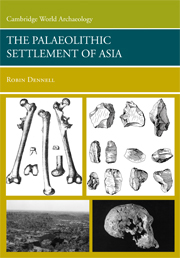Book contents
- Frontmatter
- Contents
- List of Tables, Figures, and Boxes
- Preface
- 1 Asia and Its Place in Palaeoanthropology
- 2 The African Background to the Colonisation of Asia
- 3 The Climatic and Environmental Background to Hominin Settlement in Asia before 1 MA
- 4 The Earliest Inhabitants of Southwest Asia
- 5 The Earliest Inhabitants of South and Southeast Asia and China
- 6 “Out of Africa 1” Reconsidered and the Earliest Colonisation of Asia
- 7 The Climatic and Environmental Background to Hominin Settlement in Asia between ca. 1 Ma and the Last Interglacial
- 8 The Middle Pleistocene Archaeological Record for Southwest and Central Asia
- 9 The Middle Pleistocene Archaeological Record of the Indian Subcontinent
- 10 The Middle Pleistocene Archaeological Record of China and Southeast Asia
- 11 Human Evolution in Asia during the Middle Pleistocene
- 12 Concluding Remarks
- Appendix 1 The Sizes of Countries and Regions in Asia, with Comparative Examples
- Appendix 2 Geographical Coordinates of Principal Early Palaeolithic Sites in Asia
- Appendix 3 Geographical Coordinates of Geological Sections and Cores
- Appendix 4 English Names of Various Mammals Recorded in Asia
- Bibliography
- Index
10 - The Middle Pleistocene Archaeological Record of China and Southeast Asia
Published online by Cambridge University Press: 05 June 2012
- Frontmatter
- Contents
- List of Tables, Figures, and Boxes
- Preface
- 1 Asia and Its Place in Palaeoanthropology
- 2 The African Background to the Colonisation of Asia
- 3 The Climatic and Environmental Background to Hominin Settlement in Asia before 1 MA
- 4 The Earliest Inhabitants of Southwest Asia
- 5 The Earliest Inhabitants of South and Southeast Asia and China
- 6 “Out of Africa 1” Reconsidered and the Earliest Colonisation of Asia
- 7 The Climatic and Environmental Background to Hominin Settlement in Asia between ca. 1 Ma and the Last Interglacial
- 8 The Middle Pleistocene Archaeological Record for Southwest and Central Asia
- 9 The Middle Pleistocene Archaeological Record of the Indian Subcontinent
- 10 The Middle Pleistocene Archaeological Record of China and Southeast Asia
- 11 Human Evolution in Asia during the Middle Pleistocene
- 12 Concluding Remarks
- Appendix 1 The Sizes of Countries and Regions in Asia, with Comparative Examples
- Appendix 2 Geographical Coordinates of Principal Early Palaeolithic Sites in Asia
- Appendix 3 Geographical Coordinates of Geological Sections and Cores
- Appendix 4 English Names of Various Mammals Recorded in Asia
- Bibliography
- Index
Summary
INTRODUCTION
This enormous area can be divided into a northern part, comprising China north of the Yangtse River Valley and Qinling Mountains, the Korean Peninsula, and Japan, and a southern, more humid, and warmer part that contains southern China, mainland Southeast Asia, and Indonesia. The Middle Pleistocene archaeological record is still scarce or nonexistent over large parts of both regions, and centred upon a few major sites (see Figure 10.1), by far the most important of which is Locality 1, Zhoukoudian. Chinese prehistorians have often distinguished a Lower and Middle Palaeolithic, as in areas to the west. Assemblages were classified as Middle Palaeolithic by their age (late Middle and early Upper Pleistocene) and their association with hominin remains classified as “archaic Homo sapiens”. Given uncertainties over the age of many Middle Pleistocene sites (see below) and the deeply problematic term “archaic Homo sapiens” (Chapter 11), Gao and Norton (2002) have proposed that all Middle Pleistocene lithic assemblages should be classified as Early Palaeolithic, and this approach is followed here.
NORTH CHINA
Given the profound differences in this region between glacial and interglacial climates (Chapter 7), it is likely that its hominin occupation, particularly in its northern parts, was largely confined to interglacial or interstadial times (Zhu and Zhou 1994).
- Type
- Chapter
- Information
- The Palaeolithic Settlement of Asia , pp. 396 - 437Publisher: Cambridge University PressPrint publication year: 2008



